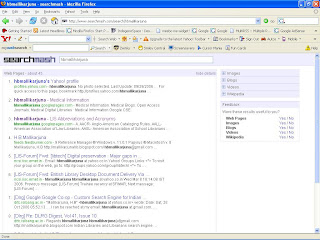
it displays search results in webimages
Hi I am Mallikarjuna H.B.

"The Tangible Archive has been developed within the Digital Library course in Summer 2004. Visitors can browse through the collection of past and current ISNM projects by picking physical objects, equipped with electronic (RFID) labels and placing them onto the "smart desk". Each object is designed as a metaphor for the respective project and triggers the project web page documentation."
"The Interactive Library Desk offers a complete new library interface based on the metaphor of a desk-top system. The active display is projected on the surface of the table using a beamer on the ceiling. The object contains an RFID label which can be detected by the RFID reader devices mounted below the table. The table supports a Content-Management-System based on XML as well as a FLASH-based interface to the table hardware. New content can be easily created and inserted into the system using most common media types for graphics, audio and video. We are constantly updating the list of services running on the table. The table design is based on the interactive table which was designed for the Museum of Castle Eutin."
"This project presents a novel user interface for library services on mobile devices. It supports library users with digital information for physical media items directly at the shelf, therefore enhancing the browsing process in physical media collections using related virtual information. PDAs, equipped with RFID or Barcode readers, allow for scanning media items and augmenting physical media items with additional information. "
| She talks what the library offers. | |

Downloading is free, but please acknowledge us by citing this paper if you use the code in research:
| Java sourcecode | ExtractAbbrev.java |
| Java Documentation | ExtractAbbrev.html |
| Sample input file | test.txt |
| Sample testing file | pairs.txt |
MedlineParser java code. Applicable to MEDLINE 2004. gzipped tar file zip file
MedlineParser perl code. Applicable to MEDLINE 2003. parsemedline.pl medline-schema-perl-oracle.sql
| Internet pioneer Ram Shriram, founding member of Google, Inc., interviewed by Safa Rashtchy sharing his insights on Web 2.0 and ingredients for creating successful internet companies. | |



Google just released another search engine-SearchMash
with different search algorithm and some additional options(e.g wikipedia results).
available at http://www.searchmash.com/
 Images - 0 Images - 0 |
No results found. |
hide details  Blogs - 2 Blogs - 2 |
|
show details  Videos - 0 Videos - 0 |
No results found. |
hide details  Wikipedia - 0 Wikipedia - 0 |
No results found. |
| Feedback | ||||||||||
Were these results useful to you?
|